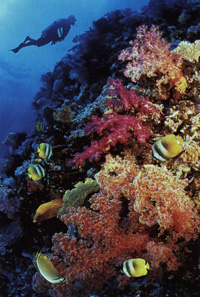
Are there any sharks there? Has someone been eaten? And are there any other dangerous animals or plants under the water, such as Box Jelly Fish and Stone Fish? In the beginning we were a little bit sceptical about attending a scuba diving course, and we asked a lot of questions before we made up our mind. Fortunately we decided to explore the underwater world, and this we never regretted
.
Along the cost of Queensland there is plenty of tropical islands. It's like paradise. The islands are almost unspoilt and have coral reefs nearby. About 20 of them have resort facilities, but it's possible to camp on many others. It is possible to see the reefs from a glass-bottom boat, or one can put on a snorkel or scuba gear and dive where the most colourful fish and corals are.
Cairns is the tourist `capital' of the Far North and one of Australia's top travellers' destinations. Not long ago, it was just a calm tropical backwater. Unfortunately, since I was there first time in 1987, much of its natural and tropical romance has vanished due to the rapid growth of tourist infrastructure. But I can ensure you; it is still one of the best bases for exploring the riches of Queensland.
From Cairns, you can arrange trips to the Great Barrier Reef, the tropical islands Green Island and Fitzroy Island. You can also visit the beautiful Atherton Tableland, the market town of Kuranda, and the spectacular rainforest and coastal scenery of Cape Tribulation and the Daintree River.
Photo: A section of the beautiful Great Barrier Reefs.
The Great Barrier Reefs
These magnificent reefs are considered one of the world's natural wonders. It is said to be the most extensive reef system and the biggest structure made by living organisms on earth. I knew that larger reefs have been discovered recently, but they lie many hundred meters below the water, and are definitely not available for Scuba divers.
The Great Barrier Reef extends 2014 km (1258 miles) along the coast of Queensland, Australia's north-east State. It reaches from the tips of Cape York Peninsula in the North to Gladstone in the South. Located from 20 to 50 km (12-32 miles) offshore, the reefs protect hundreds of islands against the waves of the Pacific Ocean.
Scuba diving
We started our course on Fitzroy Island. This idyllic island covers almost 324 hectares of lush tropical rainforest, and it is surrounded by coral reefs. Soon we were to experience a different kind of life that comes with underwater activities.
First we had to fill out some schemes about health conditions and insurance. Since we had no experience from diving we had to undergo a basic training course. At the course we learned about using the gear, decompression, how to blow water out from the mask under water and the marine life, particularly about dangerous animals we had to stay away from. We had practical training between the theoretical briefings.
Photo: Preparing the gear at Fitzroy Island.
Our first dive was in a swimming pool. Diving in the night was the most exciting experience. We had to be more careful and took it slowly. We searched for sleeping fish under the corral reefs, which we wouldn't see in daytime. Other days we found it exciting to dive in passages and caves.
Not for all in the world would we meet any Jelly Fish or Stone Fish. The last mentioned fish is almost impossible to see. This incredible ugly fish is marvellously camouflaged. One touch from a Stonefish can paralyse a person or even worse. The Box Jelly fish is also almost invisible without Polaroid glasses.
Photo: Diving at the Outer Barrier Reef.
Diving at the Outer Barrier Reef
We got a CMAS qualification, the 2 stars Diver, which is approved (acceptable) world-wide. So finally we were ready for the big test and the highlight, diving at the Outer Barrier Reef. The only way to experience the reefs is to take a seaplane or a boat. You can't walk out there!!! Of course we took the boat, because we were really curious about what was under the surface.
Our eyes widened when we saw the magnificent coral platform rise from the ocean floor. Some parts are above the water, and others beneath the waves. At low tide, part of the coral mass is visible so you can explore this enormous "aquarium".
You can also walk on the reefs at a low tide if you protect your feet by wearing rubber-soled shoes. Under the water, depth down to 10-15 metres, we saw fish in all the rainbow colours and beautiful corals. The beauty of the reefs and the life there overwhelmed us.
After a while we swam together with the fish, as if we were fish. But for one exception, one of my travel mates Geir, he is a really big man, and according to some people he looked more like a red white-sunburned whale. Because of the tide and reefs, I guess there were many shipwrecks here. We hoped to find some of them so we could search for treasures. It would have been great if we had found a valuable treasure. Then we could finance the rest of our tour.
Photo: I really enjoyed myself as the fish under the water.
Diving in these incredible marine habits is an unforgettable experience. You will explore a world you wouldn't believe existed.
But believe me; truth is stronger than fiction. It is a little bit scary at first, but when you are fascinated by the underwater world, you will soon forget your fears, and then you will want to stay under the water for the whole day.
Stein Morten Lund, 25 July 2000
